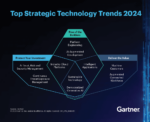
Artificial intelligence (AI) is changing how software engineering teams design, build and test applications. AI can automate much of today’s mundane software development tasks. It can also help software engineers produce code more quickly.
AI coding assistants can reduce the amount of time and effort software engineers spend on programming tasks, such as typing boilerplate code, as well as documenting, understanding, refactoring, debugging and fixing code. These tools continue to improve, enabling more complex activities to be performed. Gartner has found that by 2028, 75% of enterprise software engineers will use AI coding assistants, up from less than 10% in early 2023.
AI permeates the entire software development life cycle. Here are five ways that forward-thinking software engineers can immediately start to leverage AI for critical activities along the software-development life cycle.
No. 1: Use generative AI to write and understand software code
Generative AI code generation tools are good choices for almost any enterprise seeking AI-enabled code generation tools. The use of non-enterprise large language model (LLM) offerings, by contrast, require a number of trade-offs that many enterprises will find unacceptable. For example, prompts and code may be included in future updates to vendor products, which could lead to breach of data privacy regulations and leak critical intellectual property.
Tap plug-in coding assistants powered by machine learning to offer predictions of what single or multiline code fragments might come next, speeding development. Interact with code chat assistants in an exploratory, conversational manner to help turn a vague idea into a program.
No. 2: Deploy generative AI as an app modernization tool
Some of today’s LLM offerings can already translate software code from one language or framework to another, providing a quick and easy automated way to transform and modernize software code. GenAI tools can support developers’ app modernization efforts, but Gartner recommends limiting their use to small-scale changes. There are significant risks if code isn’t translated accurately, which can happen as a result of generative AI solutions injecting hallucinations and other factual errors into code.
No. 3: Use generative AI to explain, detect and measure technical debt and its impact
Technology debt is the amount of money that an organization must spend to meet its digital technology cost obligations and continue doing business. Technical debt is the segment that originates from software application architecture, design and development. Generative AI can help manage this burden. To effectively prioritize the debt risk and remediation cost with business partners, use generative AI to detect and measure sources of technical debt and demonstrate simply the implications, risks and level of effort required for remediation.
Don’t rely solely on generative AI products to remediate or track technical debt. Doing so is expensive and can produce inaccurate results.
No. 4: Meet user expectations for AI-powered products and services
Generative AI is forcing user experience (UX) designers to meet users’ increasing expectations of AI-driven products and services. As conversational prompt-based interfaces proliferate, users expect to see this feature in software products. Failing to provide it — and provide it well — will lead to unhappy users.
No. 5: Leverage AI across the software testing life cycle
AI is transforming software testing by enabling improved test efficacy and faster delivery cycle times.
AI augmentation can provide benefits across five areas of software testing:
- Test planning and prioritization
- Test creation and maintenance
- Test data generation
- Visual testing
- Test and defect analysis
AI-augmented testing tools can accelerate software testing. They do so by optimizing test efforts, providing early feedback about the quality of release candidates and improving the consistency of the testing experience across unit, application programming interface (API), functional and nonfunctional testing. To ensure successful deployment, instill an AI-first mentality in teams and make AI augmentation an element of a continuous quality strategy.






